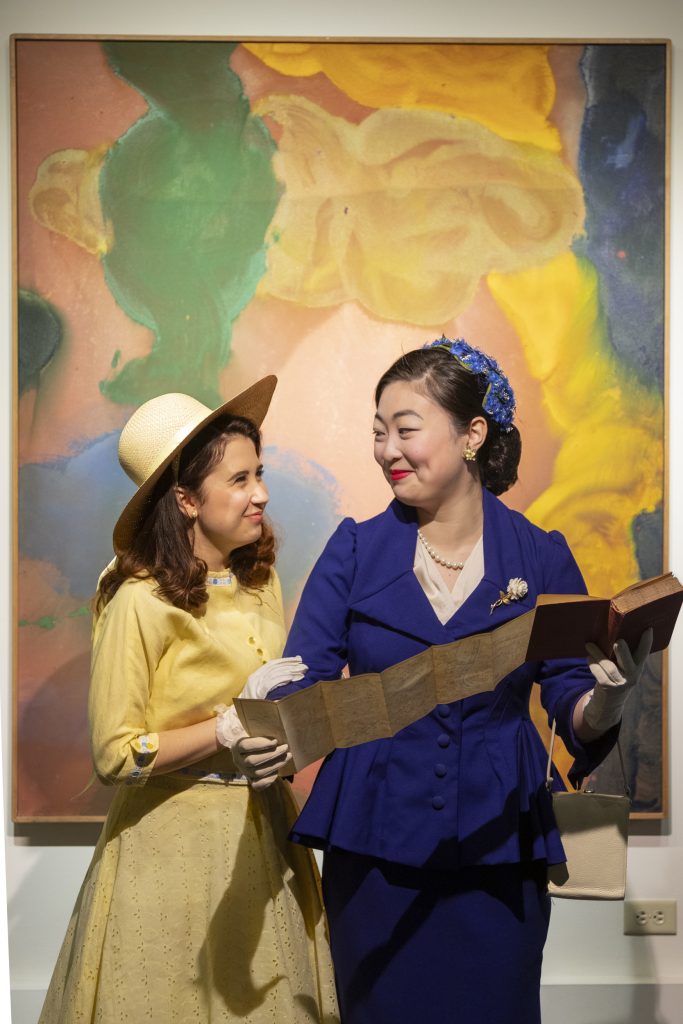The Binghamton University Art Museum opened its doors for a breathtaking production of the musical, “The Light in the Piazza” — the second installation of the spring 2024 Mainstage Productions.
Performed at 8 p.m. from April 11 to April 18, except for two shows at 2 p.m. on April 13 and 14, “The Light in the Piazza” explores an enchanting love story weaved with themes of family dynamics, mental health and identity, cultural differences, self-discovery, growth and the power of connection.
It begins with Clara — played by Gisele Domingues, a freshman majoring in musical theatre — who appeared on the overhead balcony, dressed in a pastel yellow dress, brown heels and a plastic yellow headband. She was joined by Margaret — played by Kristina Yim, a senior double-majoring in theatre and history — who wore a deep blue dress suit and dark blue heels. The mother-daughter duo broke into a harmonious song about how excited they were to visit Florence, Italy.
Fabrizio, portrayed by Samuel Katzman, a junior double-majoring in business administration and theatre, made his appearance soon after and was enchanted by the lively Clara. Despite Margaret’s efforts to keep Clara and Fabrizio apart, Act 1 concluded with Clara and Fabrizio engaging in a brief kiss, with Margaret watching, shocked by the change in events.
Tommy Iafrate, the director of both the play and the musical theatre program, shared the inspiration behind choosing to direct a production in the Art Museum.
“A few years ago, I was in the Art Museum watching the music department have a recital of their composer’s new works,” Iafrate said. “As I was sitting there listening to everything and looking around that room, in what a generative artistic space it was, I thought about how cool it would be to do theatre in that space. A musical that immediately came to mind was ‘The Light in the Piazza,’ because so many of the scenes in Piazza take place in art museums in Florence.”
He elaborated on how the eight lead characters and nine ensemble members were chosen from the 70 to 90 students who auditioned.
“[For] the audition process and the callback process, we had them sing and read scenes from a lot of the show to hear how really challenging classical music fits in their voice,” Iafrate said.
As a site-specific production, the play’s performance was very distinctive, with the actors moving through the audience as they embodied their characters. Nicholas Parker, a junior double-majoring in theatre and English who portrayed Signor Naccarelli, shared the challenges he faced when embracing the role.
“I also struggled early on with being heard,” Parker wrote in an email. “I tend to speed through my sentences and muddle my words which, when speaking with an Italian accent and sometimes in a different language entirely, it’s very difficult for people to understand at times. Over time, I really tried to slow down and articulate [and] really give myself the time I needed to speak.”
Toby Jauregui, a freshman majoring in musical theatre and a member of the ensemble, described how the movement in the space taught him certain nuances of acting.
“The movement has enforced the idea of being too much and going over the top,” Jauregui wrote in an email. “You can never be too big … It’s overall just taught me to take risks and follow my instincts in acting, which has been awesome and really important for me to learn as a growing actor.”
After the conclusion of Act 1, there was a 15-minute intermission after which Act 2 commenced. All the characters appeared after a quick costume change.
C.K. Zaki, a junior double-majoring in theatre and Spanish who designed the costumes for “The Light in the Piazza,” described how she came up with the designs for the play after extensive research.
“In America, the fashions were coming largely from Europe — from France and Italy, pointedly, at this time,” Zaki said. “1947 is when Dior debuted his new look collection — the iconic, nipped-in waist [with] fuller skirts, which were so revolutionary at the time, especially coming out of World War II when fabric was being rationed, so to have a luxurious amount of fabric on display and creating feminine shapes [inspires] some of the fashion for the characters.”
They elaborated on how mobility was important for the costume change.
“There aren’t dressing rooms nearby,” Zaki said. “So a lot of the looks are changed in one piece, [like] taking off a jacket, and that’s another costume.”
Drama unfolded in Act 2 when Margaret openly opposes the relationship between Clara and Fabrizio, but Clara fights back, standing up for herself. Relenting, Margaret speaks with Signor Naccarelli, who is pleased at first with the union but suddenly forbids the wedding during rehearsal. More heartfelt incidents of Clara’s life are shared with the audience, such as how Clara’s naive, childlike nature is the result of an accident during her adolescence. After a meaningful conversation with Margaret, Signor Naccarelli consents to the wedding, and the audience watches Clara in a beautiful white dress, joining hands with Fabrizio as Margaret sings a heartfelt song, concluding the play.
Jake Termine, an undeclared freshman who played the role of the priest, recounted which part of the play moved him the most.
“The story kind of encaptures what true love is, and how you can be a million miles away from someone and that they can be your person,” Termine said. ‘“The Light in the Piazza’ is about relationship issues, family issues [and] marital issues — a lot of issues that involve love with a lot of different subcategories. As a performer, seeing all that has just given me a new appreciation for the show and what ‘The Light in the Piazza’ really is.’”



